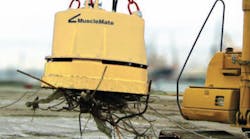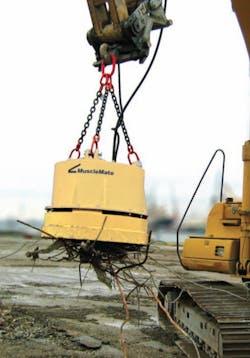Electromagnets are an essential tool for any scrap yard because they offer the quickest and easiest way to pick up steel and other ferrous metals for transfer to a shredder, compactor, or other scrap processing machine. The usual setup uses a crane, excavator, or other carrier and an auxiliary generator to produce the electricity that develops magnetic fields.
That setup is fine for full-time ferrous metals processing. But if the carrier is needed for other functions, such as digging or lifting anything other than ferrous metals, it will be out of commission until the electromagnet and cable can be removed in order to install some other implement.
Tramac Corp., Landing, N.J., has a better idea. It recently introduced MuscleMate, its new brand of hydraulic powered magnets. Instead of requiring an electrical connection to a generator, MuscleMate only requires connecting two hydraulic lines to the excavator’s hydraulic system and attaching a chain from which it is suspended.
Once it has been connected to a hydraulic system, the MuscleMate routes pressurized hydraulic fluid to a hydraulic motor. The motor drives an electric generator, which provides the power for magnetic fields. And the MuscleMate is simple to control. The equipment operator simply shifts a valve to initiate flow, which powers the motor-generator to produce magnetic fields. Returning the valve to its neutral position terminates the magnetic fields.
Tramac offers four sizes of MuscleMate, ranging from 770 to 6600 lb, with flow requirements of 4 to 12 gpm. The MuscleMate can be installed on any type of carrier that has a hydraulic source available. The generator is self-contained in the assembly and requires no additional plumbing. It also has built-in overload protection to prevent overheating or damage from excessive flow or pressure.
Mounting is fast and easy using a chain or bracket. The only other connections are two hydraulic quick-acting couplings. It is safer than a carrier using an auxiliary generator because potentially dangerous electricity is contained completely within MuscleMate. It also makes equipment more productive because processors at demolition sites can quickly change a single excavator from digging and loading to metal removal, and back again.
For more information, call Tramac Corp. at (800) 526- 3837, or visit www.muscle-mate.com.


